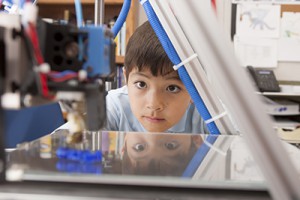 I have been reading a lot lately about 3D printers and scanners. The price of these printers is approaching consumer level, albeit the wealthy consumer level. Some of the initial hurdles have been eliminated, such as lack of raw materials and poor printing quality. With the maker movement, there is a push to make this technology available to more people so they can print their own designs and inventions. I believe the 3D printer has the potential to unleash creativity and create breakthrough items.
I have been reading a lot lately about 3D printers and scanners. The price of these printers is approaching consumer level, albeit the wealthy consumer level. Some of the initial hurdles have been eliminated, such as lack of raw materials and poor printing quality. With the maker movement, there is a push to make this technology available to more people so they can print their own designs and inventions. I believe the 3D printer has the potential to unleash creativity and create breakthrough items.
3D Printers
3D printers use raw materials such as plastic filament, metal powder, or carbon fiber to transform digital designs into solid, workable products. Makerbot, a manufacturer of 3D printers, scanners, and supplies makes a model that costs as little as $1,300. The same company also maintains the website Thingiverse, which is a repository for shared digital designs that can be used with 3D printers. There are designs for jewelry, household items, and tools like wrenches, knives, or scissors. You can share your designs, or borrow designs for use with your own 3D printer.
Innovative Ideas
3D printing is opening up a whole new world of possibilities and an alternative to mass produced items. Mike Toutonghi, a Seattle area technology manager, developed a conductive material to be used in a 3D printer after trying to help his son create an electromechanical rocket for a science project. He now has a Kickstarter campaign to create a company to further develop this material, which makes it possible for anyone to create their own solderless circuit board. I am already thinking about the possibilities.
Hershey announced a partnership with ChefJet earlier this year to print 3D chocolate. NASA is testing methods for printing food in a zero-gravity environment. If soon we can print chocolate and pizza, what other foods can we create?
Medical research companies such as Organovo are developing methods for printing human tissue in a process they call 3D bioprinting. While this raises ethical concerns—for example, imagine if people start printing their own six million dollar man—it also creates incredible opportunities. Someday we could conceivably print whole organs and not have to rely on donations to replace failing systems.
Education could be revolutionized by the technology. I saw a working 3D printer two years ago in a high school science classroom. Teachers can use them to demonstrate concepts for the visual and tactile learner, and students can use them to develop, draw, and print a model or concept. Students could gain skills in product development, design, and manufacturing all at the same time.
Thoughts
I am excited about 3D printing and the possibilities it represents. The price is dropping to the point where I could justify adding this tool to my home office. I would love to be able to print a new gear for my bicycle, or replicate that dish I broke last week, or work on a new circuit board for an invention that will change the world.
What would you create with your own 3D printer? Perhaps 2015 is the year we get one and find out for ourselves.
Kelly Brown is an IT professional, adjunct faculty for the University of Oregon, and academic director of the UO Applied Information Management Master’s Degree Program. He writes about IT and business topics that keep him up at night.



So 3d, much excitement